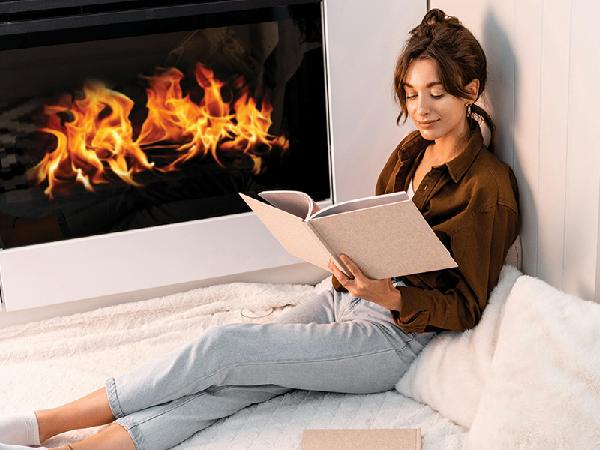How to stay safe and toasty year-round with propane appliances — indoors and outdoors.
As the weather gets cooler, the days grow shorter, and most of us spend a little more time indoors, we all start looking for new ways to make things a little cozier around the house. Warm blankets, fuzzy slippers, a steamy mug of cocoa in hand… and, completing the picture? Curling up by the fire.
For many of us, a fireplace is the ultimate in cozy. But traditional fireplaces can be a hassle — and not exactly environmentally friendly: cleaning the ash and soot after every use; having the chimney swept; all the trees lost for firewood.
With a propane fireplace, you get all the comfort and none of the inconvenience. Plus, with propane, the fireplace is one of many ways to give your home a little extra glow year-round, indoors and outside.
Why use a propane fireplace?
While a propane fireplace doesn’t come with the familiar scent of wood smoke from the chimney, it more than makes up for it in convenience, energy efficiency, and cost.
A propane fireplace is convenient and easy to use. Once installed, starting the fireplace is as simple as flipping a switch. And when it’s time to put the fire out, you just flip that switch back off. No hauling firewood, no cleaning up soot, no worries about hot coals or ash posing a safety risk.
Propane fireplaces also edge out wood and natural gas on energy efficiency. According to the Environmental Protection Agency, wood-burning fireplaces are “a very inefficient way to heat your home.” Where wood-burning fireplaces can cause the heater you use for central heat to work harder .
Meanwhile, natural gas may seem less expensive on the surface — but it’s likely that you’ll run a propane fireplace at a lower level than you would a natural gas unit, so you burn less fuel (a win for the environment) for about the same cost as natural gas (a win for your budget).
Owning a propane fireplace: cost and safety.
How much propane will a fireplace use? That depends a lot on how much you use the fireplace. As a rule, you can expect to use about one gallon of propane for every two hours you run the fireplace .
How safe is an indoor propane fireplace? For one, there is no “real” fire- or the risks that come with open flames inside your home. Installed correctly and used responsibly, propane fireplaces are as safe as any other indoor appliance connected to your propane tank.
One safety item to consider, though, is the exhaust that fireplaces produce. Even without producing the smoke that wood does, propane does emit some exhaust. The EPA recommends connecting your propane fireplace to a line in the chimney to release the exhaust outdoors. This type of set-up uses what are known as “vented” logs — facsimiles of real wood logs that are used with gas fireplaces. (By contrast, unvented logs can take oxygen out of the indoor atmosphere or increase indoor carbon monoxide levels, creating an invisible but serious health hazard.) To prevent and minimize these risks, make sure your propane fireplace installation is done by a certified professional.
Don’t forget outdoor heating fixtures.
A popular alternative or addition to indoor fireplaces is the outdoor fire pit. Easy to install, use, and maintain, fire pits come in a variety of sizes, shapes, and styles to suit your outdoor aesthetic. And they’re designed to hold a 20lb propane tank — so the fuel is quick, easy, and affordable to replace. Of course, you can also decide to go all out and install a full, built-in outdoor fireplace. In that case, you can add a line to your existing propane supply. Whichever you choose, it’s a great way to extend the possibilities for outdoor entertaining and keep things toasty year-round.
Adding propane for a fireplace? Talk to us about your usage, delivery options, pricing, and more. Or, find out where to buy propane for your outdoor fire pit.
Related content:
What Are Propane Fireplaces?
Heating Tips for Winter Put Safety First
Residential Propane Go to blog list page filtered for the category

